YOU ARE HERE: HOME / DOG BREEDS / COCKAPOO / THE COCKAPOO DOG BREED

The Cockapoo is an active and lovable cross between the clever, low allergen, Poodle and the lovely long eared Cocker Spaniel. The two pure breeds, that make up the Cocker Spaniel Poodle mix, both have working origins and are easy to train. Cockapoos are soaring in popularity due to their affectionate, friendly nature, and fun attitude to life.
Contents
- History of the Cocker Spaniel Poodle mix
- Size and appearance
- Are Cockapoos really hypoallergenic?
- Training and exercise
- Cockapoo rescue or puppies
Cockapoo size depends on whether the Poodle parent is a Miniature or Toy, but most weigh less than 30 pounds. Small enough for apartment living yet tough enough for family fun and adventures. Cocker Spaniel Poodles are ideal for a range of lifestyles, for dog sports such as agility, and will happily join you on your daily run. Most don’t bark excessively, and get along well with children, and other dogs too.
It’s hard to find a downside to this family friendly hybrid. Those awesome curls come in a wide range of colors, but do need to be kept short or thoroughly groomed on a daily basis. Of course you can always send your Cocker Poodle for a makeover like this one, every few weeks!
| Popularity: | Steady since the 1950s |
| Purpose: | Companion or assistance dogs |
| Weight: | 6–30 lbs, depending on the Poodle parent |
| Height: | 10-20 inches |
| Temperament: | Energetic, sociable, and happy. |
| Coat: | Varies from loose to tight curls |
What is a Cockapoo?
A Cockapoo is a Cocker Spaniel Poodle mix. A cross breed dog with one Cocker Spaniel parent and one Poodle parent. There are three types of Cocker Spaniel and Poodle mix, Toy, Mini and Standard. The only real difference is their size.
This will depend on whether the spaniel parent is an American or an English Cocker. And on whether the Poodle parent is a Standard, Miniature, or Toy Poodle. Most common is the Mini Cockapoo dog, bred from a Miniature Poodle.
History and Original Purpose
Both Poodles and Cocker Spaniels were originally bred as hunting dogs. Poodles were used to retrieve from water, and Cockers to hunt and flush game from undergrowth and then retrieve it. This means both dogs were bred to be intelligent, and highly trainable.
Poodles have a bit of a reputation for being aloof with strangers. And Cockers are known for their warmer, more overtly friendly nature. The two breeds were crossed in the 1950s, in an attempt to combine the Cocker’s personality with the Poodle’s tight, low shedding coat. The mix really took off in popularity in the 1960s. Making it one of the oldest ‘designer mixes’ around.
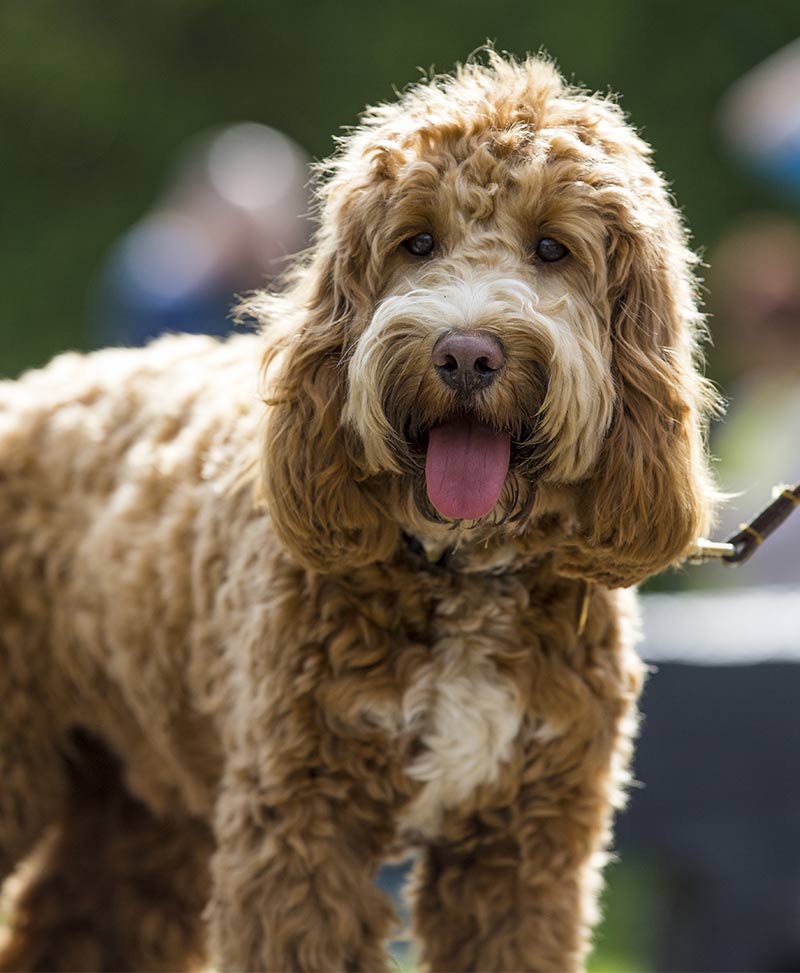
How Big Do Cockapoos Get?
Full grown Cockapoo size varies widely depending on the size of the parents, and on random chance.
| Poodle | Cocker Spaniel | Cockapoo | |
| Size: | Standard, mini or toy | Medium | Mini, small, or medium |
| Height: | Stnd: 15-24 inches Mini: 10-15 inches Toy: <10 inches | US: 13-16 inches UK: 15-17 inches | 10-20 inches |
| Weight: | Stnd: 40-70lbs Mini: 10-15lbs Toy: 4-6lbs | US: 20-30 lbs UK: 26-34 lbs | 6-30 lbs |
Cockapoo weight could potentially vary from 4 to 70lbs! At the tiny end of the scale, the teacup Cockapoo will weigh less than 6 pounds. The toy Poodle Cocker Spaniel hybrid will weigh less than 12 pounds at adulthood, and a mini Cockapoo will weigh in at anywhere from 13 to 18 pounds. A full grown miniature Cockapoo is the medium size and the one you are most likely to see at the dog park.
At the other end of the scale, a maxi Poodle and Cocker Spaniel mix, with a standard Poodle parent, will weigh 19 pounds or greater. The vast majority of Cockapoos weigh a more moderate 15-30 lbs
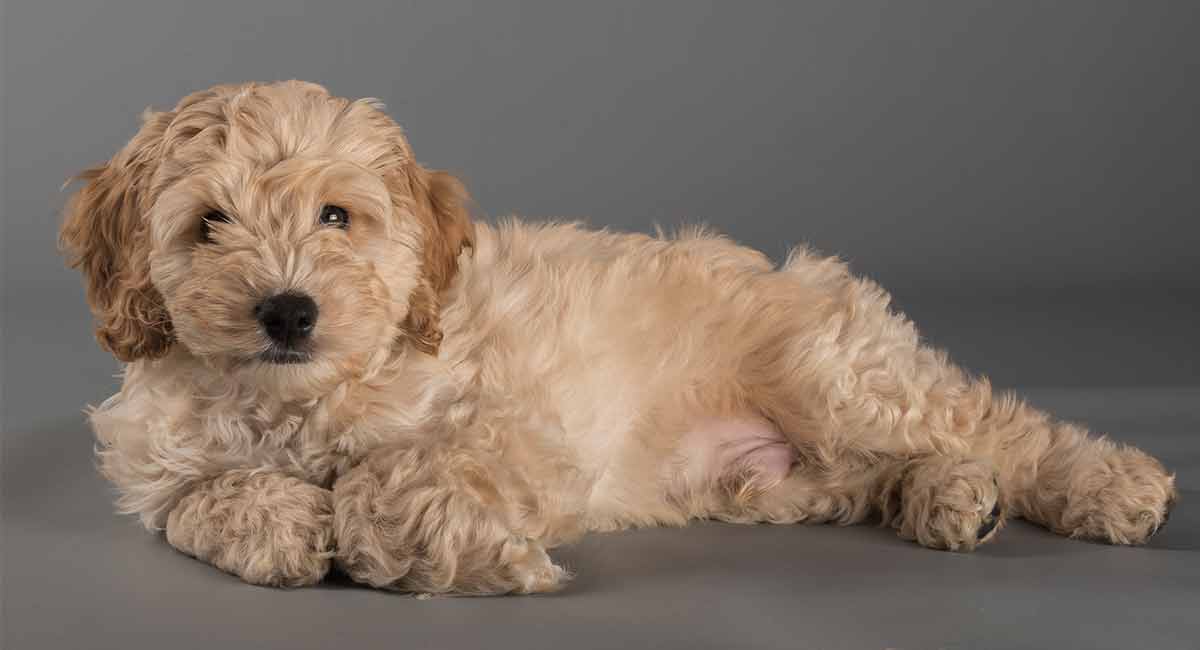
Appearance
Cocker Spaniel Poodle mixes tend to have a broader head the average Poodle. Their fur varies between loose and very tight curls.
Both Cocker Spaniels and Poodles come in a wide range of colors so there is plenty of choice for the would be cockerpoo owner.
Are Cockapoos Hypoallergenic?
The “designer dog” craze was started by a man named Wally Conron. He began crossing breeds in an effort to produce a hypoallergenic guide dog, for a blind woman whose husband was highly allergic to dogs. But Conlon couldn’t find a single purebred dog that fit the bill. So, he crossed a Labrador Retriever with a Poodle.
This is where the “Labradoodle” was born. However, even this dog wasn’t truly hypoallergenic. This is because allergies are caused by pet dander. And all pets, regardless of breed, produce some dander.
Certain dog breeds shed that dander less readily, however. This particularly applies to dogs with very curly coats. And this may be beneficial to owners with allergies to dander. Dogs that shed less fall into this category partly because loose hair remains trapped in the curls rather than floating around your home.
Do They Shed?
All dogs shed to some degree. The Poodle’s tight coat is low shedding. But the Cocker Spaniel’s is not. A Poodle and Cocker Spaniel hybrid dog can have either coat type, or something in between. And unfortunately, you cannot predict which coat they will inherit. So they may be less likely to trigger allergies. But they might not.
Remember that the tighter the curl, the less the dog is likely to shed, and if you have allergies, do spend some time with Cockapoos to see how they affect you, before you bring one into your home.

Cockapoo Temperament
The typical Cockapoo personality can be hard to predict. It can be any combination of the parent breeds’ temperaments. It is important to make sure that both parents are friendly, when you buy a Cocker Spaniel Poodle mix.
In general, Poodles are friendly, if a little ‘standoffish’ with strangers. And Cocker Spaniels are loving and very loyal. Both breeds are clever and active.
As a result, the Cockapoo’s personality, is usually a happy, fun-loving, energetic, and sociable.
Cockapoo Barking
Any dog has the capacity to bark. And may bark more if they discover barking is in some way rewarding. But some individuals of this particular breed maybe a little more prone to barking than average. Like any dog prone to barking, it’s important not to reward a Cocker Spaniel Poodle mix when they are making a noise. And to make use of resources like this one if you need to train your pup not to bark.
Training and Exercising
The good news here is that these dogs are as a whole are people-centric and eager to please. Your Poodle Cocker Spaniel mix will likely want to be where you are, doing whatever you are doing. These dogs are social and people-oriented. So, the closer your bond is, the easier Cockapoo training will become.
Throughout training, positive reinforcement will be your key to success. Poodle and Cocker Spaniel mix dogs are particularly sensitive to punishment, so avoid this at all costs.
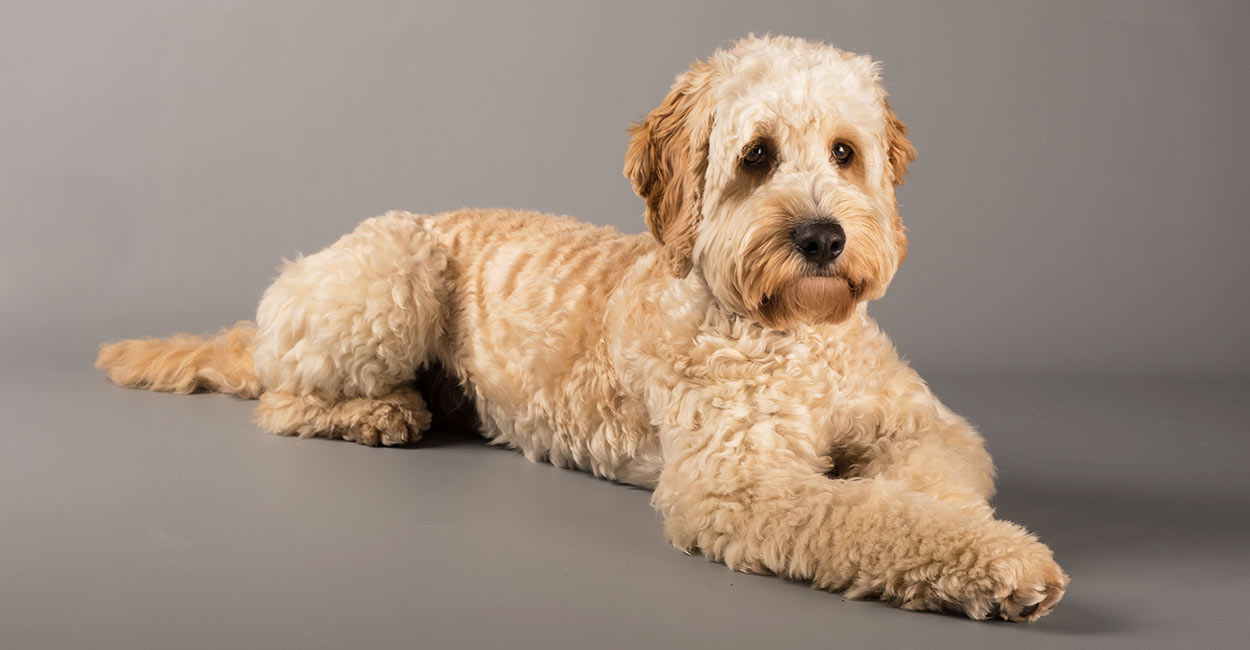
Staying Active
The Cocker Spaniel Poodle cross is an active, intelligent dog. They need daily exercise, and regular training to stimulate their minds, too. Exercise doesn’t have to mean a walk, it can be training or retrieving practice for example. The important thing is to keep your Poodle Spaniel mix busy.
Remember that young puppies have much lower exercise needs than adult dogs. A good rule of thumb is 5 minutes of structured exercise, such as walks, per month of their age, per day. At the end up the day they will still want to cuddle up on your lap, as long as they’ve spend enough energy!
Health and Care
The health problems your Poodle Cocker Spaniel mix may suffer will depend on whether their Poodle parent was a Toy, Mini, or Standard size. And on whether their spaniel parent was an American Cocker (known just as a Cocker in the USA) or an English Cocker (known just as a Cocker everywhere except the USA!).
Heart Valve Disease
Cocker Spaniels are liable to develop leaky heart valves as they grown older. This allows blood to flow ‘backwards’ in the heart, which make the heart less efficient. In the early stages medications will help extend life. But in the later stages the dog develops heart failure, a leading cause of Cocker Spaniel death. Sadly operations to repair heart valves are not yet commonly performed on dogs.
Von Willebrand’s disease>
All Poodles are at risk of von Willebrand’s disease. A blood clotting disorder that causes excessive bleeding. There is a DNA test for von Willebrand’s, which all breeding Poodles should have.
Epilepsy
Cocker spaniels are prone to epilepsy and seizures. These can often be treated with medication. It’s possible that this risk is passed onto their Cockapoo puppies.
Progressive Retinal Atrophy
Progressive retinal atrophy, or PRA, is an inherited condition. Both Poodles and Cockers are prone to this disease, which causes blindness. There is a test readily available, that will show if your puppy’s parents carry the PRA gene and can pass the disease on to their puppies.
Hip Dysplasia
Cocker spaniels and standard poodles are prone to hip dysplasia. A condition where the hip socket doesn’t form properly, and the joint doesn’t develop in the correct shape. Hip dysplasia causes pain. It affects the movement and function of the hip joint. Some cases are improved by surgery. Without surgery it can severely limit your pup’s quality of life.
Your puppy’s Cocker and standard Poodle parents should have their hips ‘scored’ by a veterinarian. Hip dysplasia is caused by multiple factors so it’s worth reading up on how to exercise your young Cocker Spaniel Poodle mix safely, too.
Patella Luxation
Toy and Miniature Poodles are among a number of smaller breeds that can suffer from Patella Luxation. This is a kneecap that ‘pops’ out of joint easily. It may require surgery.
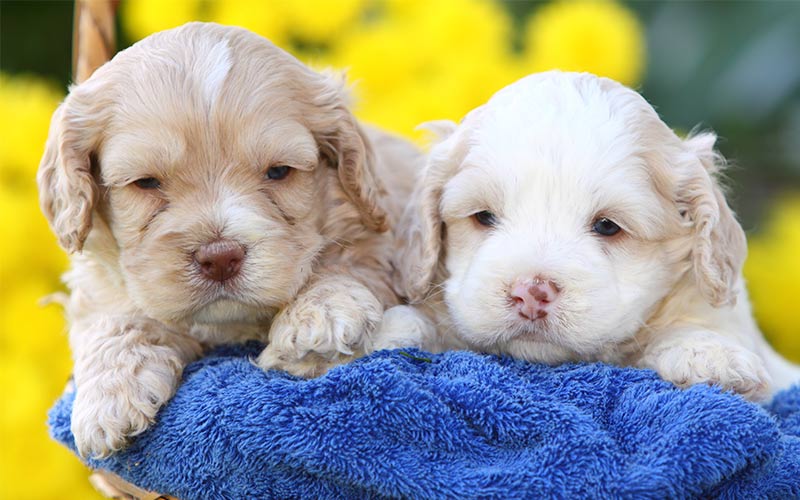
General Health of Cross Breeds
A Poodle Cocker Spaniel cross puppy can inherit heath conditions from either parent, or from both. Where a condition is only common in one of the parent breeds, the puppy’s risk should be somewhere in between the two parents’ risks.
So the problem will be less likely than it is for the ‘at risk’ breed, but still more common than average. Exactly how likely each problem is, depends on a number of unpredictable factors. You can follow these links to find out more about health risks for your puppy’s parents:
- Miniature Poodle
- Toy Poodle
- Standard Poodle
- American Cocker
- English Cocker
Both parents should have all the usual health checks and tests before being bred. Even when breeding for cross breed puppies. Only use breeders who test both parents for all the diseases relevant to their respective breeds.
General Care
Cocker Spaniels have long ears, and need help keeping these clean to reduce ear infections. Most Poodle and Cocker Spaniel crosses will need similar maintenance to keep their ears in tip top health. You’ll also need to trim your pup’s nails on a regular basic, with clippers or a nail grinder.
Coat Care
Regular grooming is essential to keep the Cocker Spaniel Poodle coat in good condition. The best way to keep this simple is to establish a daily routine of brushing for five minutes. Remember to pay particular attention to the areas around the ears, anywhere their harness sits, and their ‘trousers’.
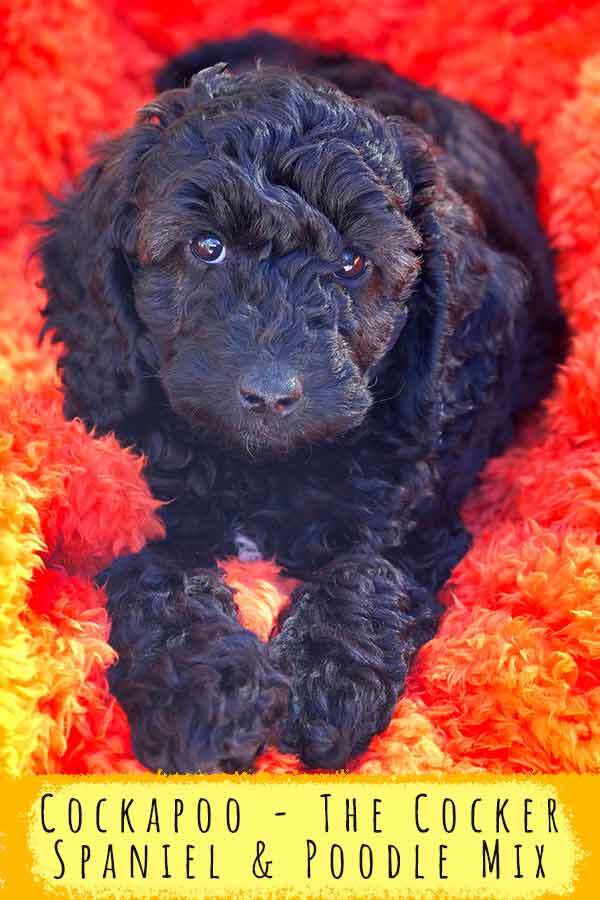
What is the Cockapoo Life Expectancy?
The life expectancy of a mixed breed dog is largely determined by the average lifespan of the parent breeds. The average lifespan of a Cocker Spaniel is 11.5 years, while the Miniature Poodle can live up to 14 years or more. The average life expectancy of a Cocker Spaniel Poodle mix is about 13 years. Mixes that include mini Poodles or English Cockers tend to live a little longer than those between American Cockers and Standard Poodles.
You can help your Cocker Spaniel and Poodle hybrid to have the best chance to a long healthy life, by making sure they eat a suitable diet, aren’t overweight, and get plenty of regular exercise.
Do Cockapoos Make Good Family Pets?
A well-bred, well-raised Cocker Spaniel Poodle can make a wonderful addition to most families. It’s important to meet the parents before choosing your puppy. This is because nice dogs generally produce nice puppies. Once your pup comes home, socialisation is key. Make sure you have lots of visitors, and introduce your puppy to lots of different sights and sounds. This will maximise your chance of having a friendly, confident, adult dog.
Cockapoos are intelligent dogs, and older children will love helping to train them.
They are social dogs, and will be happiest when there is lots of company. This means they aren’t ideal for people who out of the home for a lot of the day.
Rescuing a Cocker Spaniel Poodle dog
Rescuing a dog can be tremendously satisfying. You are giving a relinquished dog a loving forever home – what could feel better? Plus, your costs will likely be quite a bit lower, even with adoption fees and possible spay/neuter fees. Of course, there are also some trade-offs in pursuing a rescue Cockapoo.
There are relatively few rescue centers that specialise in Cocker Spaniel Poodle hybrids. However, it’s worth contacting your local rescues, to see if they have any Cockapoo dogs in. And specialist Cocker Spaniel and Poodle rescues will often take in mix breed pups too.
Finding a Poodle and Cocker Spaniel Mix Puppy
If you’re buying a puppy it’s always important to make sure you use a reputable breeder. The breeder should be happy for you to meet and spend time with both the parents, and be able to provide results for all the relevant health tests for both breeds. They may be able to provide references from previous customers.
How Much Is A Cockapoo?
Cockapoo price varies between $1000 to $3000, depending on demand in your area. Cheaper puppies without the relevant health checks can seem very tempting, but will often end up costing more in the long run. Both in vets bills, and in heart ache.
Don’t forget to factor in ongoing costs like kibble and good quality pet health insurance, when budgeting for your new friend.
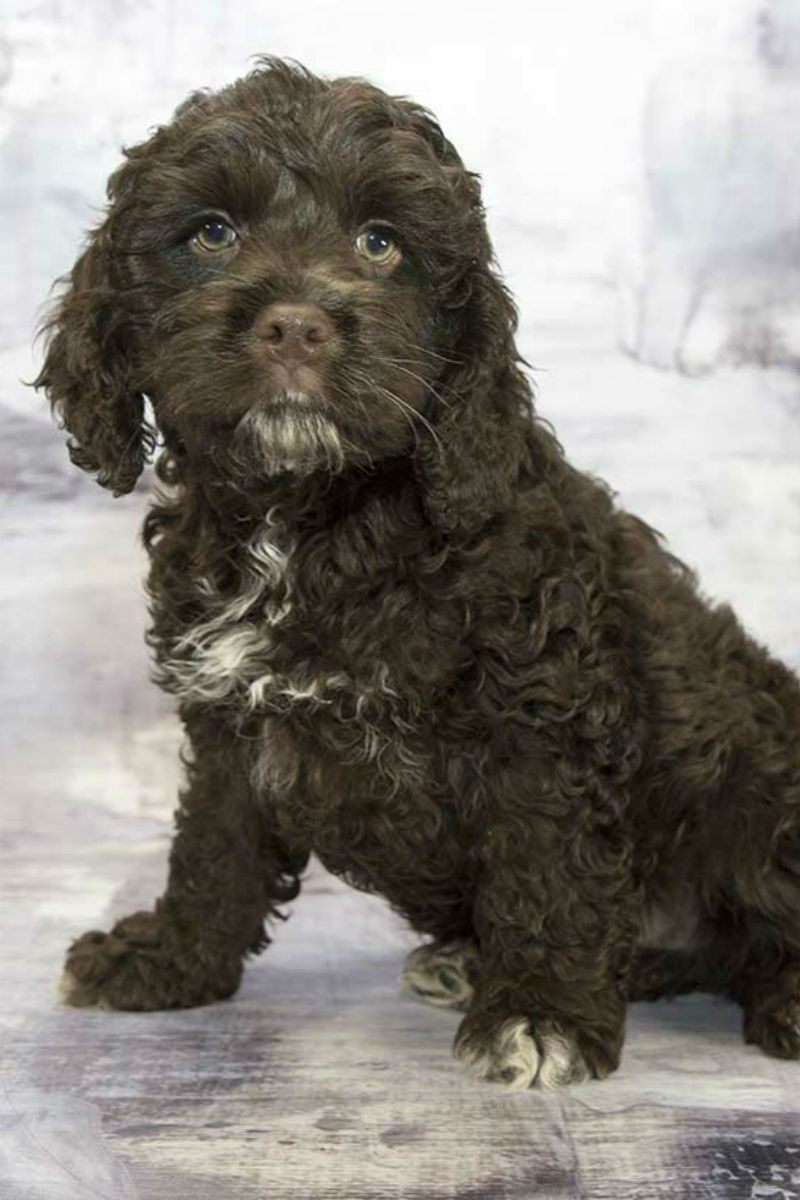

Sheila Davis says
I have a 2 year old cockapoo Luke Hudson and he is overweight and is scared of everything. My husband passed away last year and Luke was in his creat all day when my husband passed opening his creat. No I am having to have him trained so I can leave him at home with out eating my curtains and the doorknob. I love him to death. But he is a mess. Spoiled rotten .
Christa Burt says
I am looking for an adult cookapoo I am 79 years old and lost my dog 1 year ago.I would really like a companion.
Kathy French says
My mother had 4 poodles and a cockapoo which we lost 3 mo ago. She says she can’t lice without a dog so she would like a Pomapoo.
Sonja Foster says
I would like a small Cockapoos dog around 1-2 years old small, a lap dog, female. I want a friendly outgoing dog that is not afraid of strangers. I am a older widow that just lost shelter. I would would want one that did not shed!
Bruce Schmidt says
We are debating between a cockapoo and a goldendoodle. So you also breed goldendoodles? If not if there a breeder in S Carolina that you would recommend? We live on Hilton Island.
Do you have thoughts on the two breeds. It must be less then 50 lbs due to condo association restrictions.
You have come highly recommended by two of our close friends.
Any help you can provide would be greatly appreciated.
Thank you.
JOANNA KOVACS says
I have a 9 weeks old Cockapoo half poodle half spaniel have hard time training her bite all the times give lots toyes any suggestions
Debi says
Looking for a female F1 English Toy Cockapoo
Adult 1-2 year old ok
Quinn Matz says
Looking for a full sized cockapoo in PA
Jennifer says
Looking for a cockepoo.my daughter is fur baby sitter and fell in love with a beautiful cocker pop named Huntley. We presently have a sweet girl beshonpoo that is 7 years old.
Sara Difiori says
If you are in california try the cockapoodle ranch – our adorable little male came from there, and he has such a sweet temper.
Yazmin Urena says
Owner of w2 cockapoo boys. They are my world, super opposite personalities but they are both great ones . Tevo the adventurous, licker that loves to open car windows and pulls door handles open at home to jump on our beds, always keeps me laughing, and Toby the mellow, mamas boy never leaves my side , melts my heart with his marble eyes..they are super smart and behave wherever i decide to take them with me since i registered them as service animals. In love with both my boys!!!
Lupe Guillen says
May I ask how and where to purchase service dog permits? My cockerpoo is 3 mos old and when I have a apt I have to leave her. I feel so bad. She calms me down as well as I calm her down.
Rousimary says
I just love one after nine years in my life . She was my second daughter. I m still have a lot pain but the last week I decide by another puppy whe I see my little Bella a cocker poodle brown with a green eyes she is now my baby I love her.
Max Sayer says
I really enjoy dogs and have been thinking about getting one for my family. I really appreciated the section on if they are hypoallergenic because some of my family have a slight reaction. Also, I never realized that every breed of dog produces some dander, however minimal.
Nicole says
We have a cockapoo and just love the breed. This is our 2nd one, both our dogs have (and had) great tempermants -1st dog Buddy raised with children and Chippy -2nd dog with aggrevating teasing teenagers. Both were and is mom’s dog and very protective. Would and have recommend this breed anytime–love (d) my dog to pieces.
Joni says
Love my coccopoodle her name is Nikki. As a older woman was not looking for a puppy,but now I can’t imagine my life without her.
Jenanda says
Just got a cockapoo who was a ‘mistake’ … his mum, a red cocker, was left by her human mum to go shopping … the human mums’ son had a miniature chocolate poodle. You’ve guessed it … they got together and made 2 gorgeous puppies one of whom came to live with me! He is 14 weeks old and has got round to sleeping in the hearth with my 8 year old Cavalier King Charles Spaniel. They seem to be good friends and this bodes well for the future. He is happy and lively and looking forwards to being able to get down outside and walk instead of riding in my arms or on the pram. His first puppy party is on 30 January and training starts on 20 February. He can already do most of the puppy good citizens certificate at home but this may change with other little distractions around! It doesn’t take many times of telling for him to know what I am saying and he responds well to the clicker. He is very intelligent!